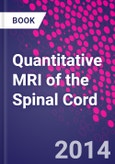Quantitative MRI of the Spinal Cord introduces the theory behind each quantitative technique, reviews each theory's applications in the human spinal cord and describes its pros and cons, and suggests a simple protocol for applying each quantitative technique to the spinal cord.
Please Note: This is an On Demand product, delivery may take up to 11 working days after payment has been received.
Table of Contents
1. Quantitative Biomarkers in the Spinal Cord: What For? 1.1 Rationale for Quantitative MRI of the Human Spinal Cord and Clinical Applications 1.2 Inflammatory Demyelinating Diseases 1.3A Acute SCI and Prognosis 1.3B Chronic SCI and Recovery
2. Physics of MRI 2.1 Array Coils 2.2 B0 Inhomogeneity and Shimming 2.3 Susceptibility Artifacts 2.4 Ultra-High Field
3. Imaging Spinal Cord Structure 3.1 Diffusion-Weighted Imaging 3.2 Q-Space Imaging 3.3 Model-Based Microstructure Imaging: A Future Perspective 3.4 Magnetization Transfer 3.5 T2 Relaxation 3.6 Atrophy
4. Imaging Spinal Cord Function 4.1 fMRI Using BOLD 4.2 Physiological Noise Modeling 4.3 Mapping the Vasculature of the Spinal Cord
5. Spectroscopy 5.1 Quantifying Metabolite Concentration
Annex: Anatomy of the Spinal Cord








